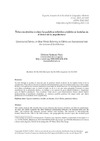Identificador persistente para citar o vincular este elemento:
https://accedacris.ulpgc.es/handle/10553/77676
| Campo DC | Valor | idioma |
|---|---|---|
| dc.contributor.author | Serrano-Niza, Dolores | en_US |
| dc.date.accessioned | 2021-02-10T16:29:11Z | - |
| dc.date.available | 2021-02-10T16:29:11Z | - |
| dc.date.issued | 2021 | en_US |
| dc.identifier.issn | 2341-1112 | en_US |
| dc.identifier.uri | https://accedacris.ulpgc.es/handle/10553/77676 | - |
| dc.description.abstract | En este trabajo se analiza el trasvase que se produce desde el léxico de los tejidos hasta el de la arquitectura. Para ello se estudia la estrecha relación histórica que ha existido entre uno y otro campo técnico y se explican las razones semánticas causantes de dicho trasvase. La investigación se enmarca en la línea cronológica que va desde el siglo XIII al XVI y en una zona geográfica concreta, la zona meridional de la península ibérica; un tiempo y un espacio de gran interés histórico y lingüístico para el objetivo planteado. Tras examinar cómo eran y qué funcionalidad tenían ciertos tejidos pertenecientes al mobiliario doméstico, se analizan aquellas palabras de origen árabe que ahora pertenecen al vocabulario de la arquitectura. | en_US |
| dc.description.abstract | This article analyses the transfer that occurs between the lexicon of fabrics and that of architecture. As such, the article examines the close historical relationship between one technical field and the other, and explains the semantic reasons behind such transfer. The research is chronologically framed between the 13th to the 16th century, and geographically focused upon the southern part of the Iberian Peninsula, because these are a time and place of great historical and linguistic interest for the stated objective. After examining the nature and functionality of certain fabrics pertaining to home furnishings, analysis turns to those words of Arabic origin that now belong to the vocabulary of architecture. | en_US |
| dc.language | spa | en_US |
| dc.relation | PGC2018-093835-B-100 | en_US |
| dc.relation.ispartof | Vegueta: Anuario de la Facultad de Geografía e Historia | en_US |
| dc.source | Vegueta: Anuario de la Facultad de Geografía e Historia [ISSN 1133-598X], v. 21 (1), p. 637-658 | en_US |
| dc.subject | 550601 Historia de la arquitectura | en_US |
| dc.subject | 5101 Antropología cultural | en_US |
| dc.subject.other | Espacio doméstico | en_US |
| dc.subject.other | Textiles | en_US |
| dc.subject.other | Arabismos | en_US |
| dc.subject.other | Edad Media | en_US |
| dc.subject.other | Península ibérica | en_US |
| dc.subject.other | Domestic Space | en_US |
| dc.subject.other | Textiles | en_US |
| dc.subject.other | Arabisms | en_US |
| dc.subject.other | Middle Ages | en_US |
| dc.subject.other | Iberian Peninsula | en_US |
| dc.title | Telas construidas o cómo las palabras referidas a tejidos se instalan en el léxico de la arquitectura | en_US |
| dc.title.alternative | Constructed Fabrics, or How Words Referring to Fabrics are Incorporated into the Lexicon of Architecture | en_US |
| dc.type | info:eu-repo/semantics/article | en_US |
| dc.type | Article | en_US |
| dc.identifier.doi | 10.51349/veg.2021.1.24 | en_US |
| dc.description.lastpage | 658 | en_US |
| dc.identifier.issue | 1 | - |
| dc.description.firstpage | 637 | en_US |
| dc.relation.volume | 21 | en_US |
| dc.investigacion | Artes y Humanidades | en_US |
| dc.type2 | Artículo | en_US |
| dc.identifier.ulpgc | Sí | en_US |
| dc.description.sjr | 0,2 | |
| dc.description.sjrq | Q1 | |
| dc.description.esci | ESCI | |
| dc.description.fecytq | Q2 | |
| dc.description.fecytpuntuacion | 38,28 | |
| dc.description.dialnetimpact | 0,0 | |
| dc.description.dialnetq | Q1 | |
| dc.description.dialnetd | D2 | |
| dc.description.miaricds | 10,0 | |
| dc.description.erihplus | ERIH PLUS | |
| item.grantfulltext | open | - |
| item.fulltext | Con texto completo | - |
| Colección: | Artículos | |
Citas de WEB OF SCIENCETM
Citations
1
actualizado el 08-jun-2025
Visitas
147
actualizado el 11-ene-2025
Descargas
106
actualizado el 11-ene-2025
Google ScholarTM
Verifica
Altmetric
Comparte
Exporta metadatos
Los elementos en ULPGC accedaCRIS están protegidos por derechos de autor con todos los derechos reservados, a menos que se indique lo contrario.
